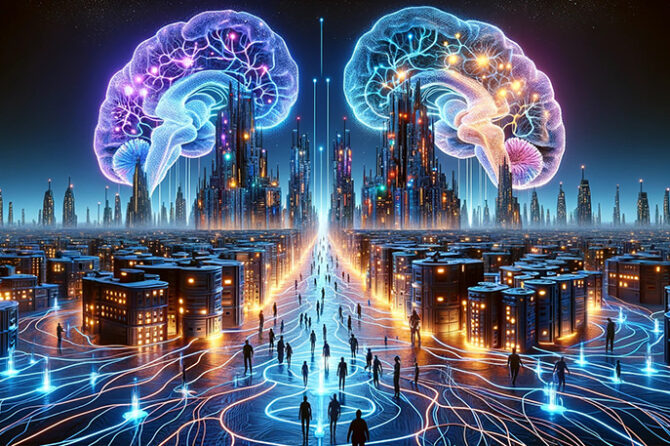
The behavioural psychology have long been fascinated by the intricate mechanisms that guide our social decisions A recent ground-breaking study spearheaded by Read Montague and an international team at Virginia Tech has illuminated the complex interplay between two key neuromodulators, serotonin, and dopamine, in the context of social decision-making. This research, leveraging the unique clinical setting of Parkinson’s disease patients undergoing awake brain surgery, employs cutting-edge carbon-fibre electrode technology to offer an unprecedented glimpse into our brain’s neurochemical dance during social interactions.
Understanding the Neurochemical Symphony
At the heart of this study is the exploration of how dopamine and serotonin levels dynamically interact to shape our decisions in social contexts. The research employs the “ultimatum game,” a scenario where subjects must choose to accept or reject monetary splits from both human and computer opponents, to reveal that our responses are significantly swayed by whether we are interacting with humans or machines.
Dopamine-Serotonin Interactions in Social Contexts
Dopamine’s role appears to be akin to a continuous tracking system, reacting to the relative value of current offers compared to previous ones. Serotonin, on the other hand, evaluates the current offer’s value on a case-by-case basis. This nuanced interaction suggests a sophisticated neurochemical mechanism underlying our social behaviours, with dopamine levels generally higher when interacting with humans, indicating the importance of fairness in social engagements.
Technological Innovations and Insights
The utilization of innovative carbon-fibre electrodes by Seth Batten and the research team has opened a new frontier in measuring neurotransmitters in the human brain, allowing for the simultaneous tracking of dopamine and serotonin. This methodological breakthrough not only enhances our understanding of these neuromodulators’ roles but also underscores the complexity of their interaction in social decision-making processes.
Implications for Psychiatric Disorders
This research holds significant implications for understanding and treating psychiatric conditions, providing a deeper insight into the neurochemical foundations of social behaviour. By uncovering the dynamic relationship between dopamine and serotonin in social contexts, the study paves the way for more precise and effective treatments for various brain disorders, offering hope for addressing conditions where traditional pharmacological interventions have fallen short.
Challenges and Future Directions
Deciphering the electrochemical signals and distinguishing between dopamine, serotonin, and other neurotransmitters posed a considerable challenge, tackled through advanced machine learning tools. This endeavour, as Ken Kishida points out, is just the beginning of a long journey towards understanding the full spectrum of neurotransmitter dynamics in relation to human cognition and behaviour.
A Gateway to Understanding Human Behaviour
This study not only provides a novel understanding of the neurochemical basis of social decision-making but also serves as a testament to the power of interdisciplinary collaboration and technological innovation in unravelling the mysteries of the human brain. As we continue to explore the roles of dopamine and serotonin, we edge closer to answering fundamental questions about what makes us human and how our brains navigate the complexities of social interactions.
Summary
The collaborative efforts of Read Montague, Dan Bang, Seth Batten, Ken Kishida, and their colleagues have significantly advanced our understanding of the neurochemical underpinnings of social decision-making. By illuminating the roles of dopamine and serotonin in this process, their research offers new avenues for treating psychiatric disorders and deepens our understanding of human behaviour. As we move forward, the insights garnered from this study will undoubtedly shape the future of neuroscience, psychiatry, and beyond, highlighting the intricate dance of neurochemicals that defines our social existence.
Prof. Dr. Prahlada N. B
4th March 2024
Chitradurga.

















Prahlada Sir 💐
Nice blog topic on two
Neurotransmitters today.
"Serotonin and dopamine are two essential neurotransmitters that play crucial roles in various aspects of our lives, including social interactions."
SEROTONIN is often referred to as the "feel-good" neurotransmitter, as it contributes to feelings of well-being and happiness. In social interactions, serotonin helps regulate our mood and social behavior. It plays a significant role in social bonding, trust, and cooperation. When we engage in positive social experiences, serotonin levels increase, making us feel more connected and content with our social relationships. Additionally, serotonin helps us process social cues and non-verbal communication, such as body language and facial expressions, which are essential for effective communication and understanding others' emotions.
DOPAMINE , on the other hand, is known as the "reward" neurotransmitter. It is involved in reinforcing behaviors that are pleasurable or beneficial to our survival. In social interactions, dopamine contributes to our motivation and drive to engage in social activities, form relationships, and maintain connections with others. It plays a role in the anticipation of rewards, such as the excitement of meeting new people or the pleasure derived from social interactions. Dopamine also helps in learning from social experiences, as it is involved in the formation of new memories and the strengthening of neural connections related to social encounters.
In summary, serotonin and dopamine both play essential roles in social interactions by influencing our mood, motivation, and ability to form and maintain relationships. They help us navigate social situations, process emotions, and learn from our experiences. A healthy balance of these neurotransmitters is crucial for maintaining positive and fulfilling social interactions.
Reply